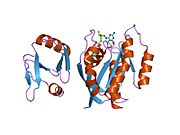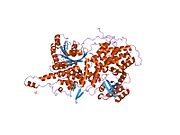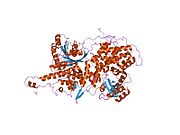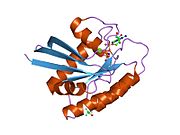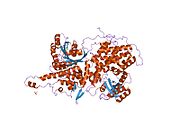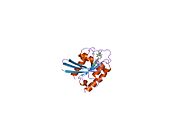KRAS
Ensembl | |||||||||
|---|---|---|---|---|---|---|---|---|---|
| UniProt | |||||||||
| RefSeq (mRNA) | |||||||||
| RefSeq (protein) |
| ||||||||
| Location (UCSC) | Chr 12: 25.21 – 25.25 Mb | Chr 6: 145.16 – 145.2 Mb | |||||||
| PubMed search | [3] | [4] | |||||||
| View/Edit Human | View/Edit Mouse |
KRAS (
The K-Ras protein is a GTPase, a class of enzymes which convert the nucleotide guanosine triphosphate (GTP) into guanosine diphosphate (GDP). In this way the K-Ras protein acts like a switch that is turned on and off by the GTP and GDP molecules. To transmit signals, it must be turned on by attaching (binding) to a molecule of GTP. The K-Ras protein is turned off (inactivated) when it converts the GTP to GDP. When the protein is bound to GDP, it does not relay signals to the nucleus.
The
Function
KRAS acts as a molecular on/off switch, using
Other members of the Ras family include: HRAS and NRAS. These proteins all are regulated in the same manner and appear to differ in their sites of action within the cell.[citation needed]
Clinical significance when mutated
This
Several
Somatic KRAS mutations are found at high rates in leukemias, colorectal cancer,[15] pancreatic cancer[16] and lung cancer.[17]
Colorectal cancer
The impact of KRAS mutations is heavily dependent on the order of mutations. Primary KRAS mutations generally lead to a self-limiting hyperplastic or borderline lesion, but if they occur after a previous
As of 2006, KRAS mutation was predictive of a very poor response to panitumumab (Vectibix) and cetuximab (Erbitux) therapy in colorectal cancer.[21]
As of 2008, the most reliable way to predict whether a colorectal cancer patient will respond to one of the
As of 2009 although presence of the wild-type (or normal) KRAS gene does not guarantee that these drugs will work, a number of large studies[23][24] had shown that cetuximab had efficacy in mCRC patients with KRAS wild-type tumors. In the Phase III CRYSTAL study, published in 2009, patients with the wild-type KRAS gene treated with Erbitux plus chemotherapy showed a response rate of up to 59% compared to those treated with chemotherapy alone. Patients with the KRAS wild-type gene also showed a 32% decreased risk of disease progression compared to patients receiving chemotherapy alone.[24]
As of 2012 it was known that emergence of KRAS mutations was a frequent driver of acquired resistance to cetuximab anti-EGFR therapy in colorectal cancers. The emergence of KRAS mutant clones can be detected non-invasively[how?] months before radiographic progression. It suggests to perform an early initiation of a MEK inhibitor as a rational strategy for delaying or reversing drug resistance.[25]
KRAS amplification
KRAS gene can also be
Lung cancer
Whether a patient is positive or negative for a mutation in the epidermal growth factor receptor (EGFR) will predict how patients will respond to certain EGFR antagonists such as erlotinib (Tarceva) or gefitinib (Iressa). Patients who harbor an EGFR mutation have a 60% response rate to erlotinib. However, the mutation of KRAS and EGFR are generally mutually exclusive.[29][30][31] Lung cancer patients who are positive for KRAS mutation (and the EGFR status would be wild type) have a low response rate to erlotinib or gefitinib estimated at 5% or less.[29]
Different types of data including mutation status and gene expression did not have a significant prognostic power.[32] No correlation to survival was observed in 72% of all studies with KRAS sequencing performed in non-small cell lung cancer (NSCLC).[32] However, KRAS mutations can not only affect the gene itself and the expression of the corresponding protein, but can also influence the expression of other downstream genes involved in crucial pathways regulating cell growth, differentiation and apoptosis. The different expression of these genes in KRAS-mutant tumors might have a more prominent role in affecting patient's clinical outcomes.[32]
A 2008 paper published in Cancer Research concluded that the in vivo administration of the compound oncrasin-1 "suppressed the growth of K-ras mutant human lung tumor xenografts by >70% and prolonged the survival of nude mice bearing these tumors, without causing detectable toxicity", and that the "results indicate that oncrasin-1 or its active analogues could be a novel class of anticancer agents which effectively kill K-Ras mutant cancer cells."[33]
Pancreatic cancer
Over 90% of
KRAS testing
In July 2009, the US Food and Drug Administration (FDA) updated the labels of two anti-EGFR monoclonal antibody drugs indicated for treatment of metastatic colorectal cancer, panitumumab (Vectibix) and cetuximab (Erbitux), to include information about KRAS mutations.[40]
In 2012, the FDA cleared a genetic test by
As a therapeutic target
As of 2014, driver mutations in KRAS were known to underlie the pathogenesis of up to 20% of human cancers.[42] Hence KRAS is an attractive drug target, but as of 2018 lack of obvious binding sites had hindered pharmaceutical development.[43] One potential drug interaction site is where GTP/GDP binds, but due to the extraordinarily high affinity of GTP/GDP for this site, it appeared unlikely as of 2018 that drug-like small molecule inhibitors could compete with GTP/GDP binding. Other than where GTP/GDP binds, there are no obvious high affinity binding sites for small molecules.[44]
G12C mutation

One fairly frequent driver mutation is KRASG12C which is adjacent a shallow binding site. As of 2019, this allowed the development of
In 2021, the U.S. FDA approved one KRASG12C mutant
A second is
A phase Ia/Ib dose escalation trial of the oral selective KRAS G12C inhibitor divarasib was published in 2023, where the drug was tested in non-small cell lung cancer, colorectal cancer, and other solid tumors with KRAS G12C mutations.[55] It continues in phase I and II studies for several cancer types as of August 2023.[56][57][58][59]
G12D mutation
The most common KRAS mutation is G12D which is estimated to be present in up to 37% pancreatic cancers and over 12% of colorectal cancers. Normally amino acid position 12 of the KRAS protein is occupied by glycine but in G12D it is occupied by aspartic acid.[60]
As of 2023, there are no commercial drug candidates targeting the KRAS G12D mutation in the clinical phase of development.
A novel inhibitor finding strategy for mutated G12D KRAS molecules was described in.[61] The KRAS mutations in the 12th residue position inhibit the bound of the regulatory GAP molecule to the mutated KRAS, causing uncontrolled cell growth. The novel strategy proposes finding small glue molecules, which attach the mutated KRAS to the GAP, prohibiting uncontrolled cell growth and restoring the normal function. For this goal a theoretical KRAS-GAP conformation was designed with a several Å gap between the molecules, and a high-throughput in silico docking was performed for finding gluing agents. As a proof of concept, two novel molecules were described with satisfying biological activity.
As of 2021, there were a number of drug candidates in
In 2021, the first clinical trial of a gene therapy targeting KRAS G12D was recruiting patients, sponsored by the National Cancer Institute.[64]
In June 2022, a case report was published about a 71-year-old woman with metastatic pancreatic cancer after extensive treatment (
Interactions
KRAS has been shown to
References
- ^ a b c GRCh38: Ensembl release 89: ENSG00000133703 – Ensembl, May 2017
- ^ a b c GRCm38: Ensembl release 89: ENSMUSG00000030265 – Ensembl, May 2017
- ^ "Human PubMed Reference:". National Center for Biotechnology Information, U.S. National Library of Medicine.
- ^ "Mouse PubMed Reference:". National Center for Biotechnology Information, U.S. National Library of Medicine.
- PMID 6287573.
- PMID 228228.
- PMID 16269215.
- S2CID 20878317.
- PMID 19661383.
- PMID 21743433.
- S2CID 27328214.
- PMID 23599154.
- S2CID 8193354.
- S2CID 28915489.
- PMID 2648401.
- S2CID 22457575.
- S2CID 14795296.
- S2CID 205383514.
- PMID 22427238.
- PMID 23348904.
- PMID 16618717.
- ^ van Epps HL (Winter 2008). "Bittersweet Gene". CURE (Cancer Updates, Research and Education). Archived from the original on 2009-02-07.
- PMID 19114683.
- ^ PMID 19339720.
- PMID 22722830.
- S2CID 1791682.
- .
- PMID 24874471.
- ^ S2CID 19626219.
- PMID 19349489.
- PMID 15696205.
- ^ PMID 27859136.
- PMID 18794128.
- ^ PMID 33672917.
- ISBN 978-3-031-38623-7.
- ^ Rosenzwieg A (8 June 2021). "5 Things to Know About Targeting Mutant KRAS in Pancreatic Cancer". Pancreatic Cancer Action Network.
- S2CID 263967602.
- PMID 36531078.
- ^ Clinical trial number NCT05737706 for "Study of MRTX1133 in Patients With Advanced Solid Tumors Harboring a KRAS G12D Mutation" at ClinicalTrials.gov
- ^ OncoGenetics.Org (July 2009). "FDA updates Vectibix and Erbitux labels with KRAS testing info". OncoGenetics.Org. Archived from the original on November 9, 2014. Retrieved 2009-07-20.
- ^ FDA: Medical devices: therascreen® KRAS RGQ PCR Kit – P110030, accessed 20 Jone 2014
- PMID 25323927.
- S2CID 52897928.
- PMID 29101115.
- S2CID 204969251.
- S2CID 209313106.
- S2CID 73414179.
- ^ "FDA Approves First Targeted Therapy for Lung Cancer Mutation Previously Considered Resistant to Drug Therapy". U.S. Food and Drug Administration (FDA). 28 May 2021. Retrieved 28 May 2021.
- ^ NCI Staff (2021-06-25). "Sotorasib is First KRAS Inhibitor Approved by FDA - NCI". Cancer Currents. National Cancer Institute. Retrieved 2022-06-04.
- ^ Clinical trial number NCT03785249 for "MRTX849 in Patients With Cancer Having a KRAS G12C Mutation" at ClinicalTrials.gov
- ^ Kaiser J (2019-10-30). "Two new drugs finally hit 'undruggable' cancer target, providing hope for treatments". Science Magazine. AAAS. Retrieved 2019-11-04.
- PMID 31267080.
- ^ Clinical trial number NCT03101839 for "Phase I Dose-Escalation Study of AZD4785 in Patients With Advanced Solid Tumours" at ClinicalTrials.gov
- ^ Plieth J (26 April 2019). "Astra's first attempt fails, but there's no giving up on KRAS". Evaluate.
- S2CID 261098837.
- ^ "Study Record | A Study of Multiple Therapies in Biomarker-Selected Patients With Resectable Stages IB-III Non-Small Cell Lung Cancer". clinicaltrials.gov. Retrieved 2023-08-26.
- ^ "Study Record | A Study Evaluating the Safety and Efficacy of Targeted Therapies in Subpopulations of Patients With Metastatic Colorectal Cancer (INTRINSIC)". clinicaltrials.gov. Retrieved 2023-08-26.
- ^ "Study Record | A Study to Evaluate the Safety, Pharmacokinetics, and Activity of GDC-6036 Alone or in Combination in Participants With Advanced or Metastatic Solid Tumors With a KRAS G12C Mutation". clinicaltrials.gov. Retrieved 2023-08-26.
- ^ "Study Record | A Study to Evaluate the Efficacy and Safety of Multiple Targeted Therapies as Treatments for Participants With Non-Small Cell Lung Cancer (NSCLC) (B-FAST)". clinicaltrials.gov. Retrieved 2023-08-26.
- PMID 35046095.
- PMID 38473821.
- ^ "Mirati Therapeutics Reports Investigational Adagrasib (MRTX849) Preliminary Data Demonstrating Tolerability and Durable Anti-Tumor Activity as well as Initial MRTX1133 Preclinical Data". ir.mirati.com. Retrieved 26 July 2021.
- ^ "RMC-9805 (RM-036), a First-in-Class, Orally-Bioavailable, Tri-Complex Covalent KRAS-G12D(ON) Inhibitor, Drives Profound Anti-Tumor Activity in KRAS-G12D Mutant Tumor Models". Revolution Medicines. Retrieved 2023-01-29.
- ^ "A Phase I/II Study Administering Peripheral Blood Lymphocytes Transduced With a Murine T-Cell Receptor Recognizing the G12D Variant of Mutated RAS in HLA-A*11:01 Patients". clinicaltrials.gov. 28 January 2021. Retrieved 26 July 2021.
- PMID 35648703.
- ^ PMID 10783161.
- PMID 10882715.
- PMID 10542052.
- PMID 7809086.
- PMID 12732644.
- PMID 11585916.
Further reading
- Kahn S, Yamamoto F, Almoguera C, Winter E, Forrester K, Jordano J, et al. (1987). "The c-K-ras gene and human cancer (review)". Anticancer Research. 7 (4A): 639–652. PMID 3310850.
- Yamamoto F, Nakano H, Neville C, Perucho M (1985). "Structure and mechanisms of activation of c-K-ras oncogenes in human lung cancer". Progress in Medical Virology. 32: 101–114. PMID 3895297.
- Porta M, Ayude D, Alguacil J, Jariod M (February 2003). "Exploring environmental causes of altered ras effects: fragmentation plus integration?". Molecular Carcinogenesis. 36 (2): 45–52. S2CID 23937262.
- Smakman N, Borel Rinkes IH, Voest EE, Kranenburg O (November 2005). "Control of colorectal metastasis formation by K-Ras". Biochimica et Biophysica Acta (BBA) - Reviews on Cancer. 1756 (2): 103–114. PMID 16098678.
- Castagnola P, Giaretti W (November 2005). "Mutant KRAS, chromosomal instability and prognosis in colorectal cancer". Biochimica et Biophysica Acta (BBA) - Reviews on Cancer. 1756 (2): 115–125. PMID 16112461.
- Deramaudt T, Rustgi AK (November 2005). "Mutant KRAS in the initiation of pancreatic cancer". Biochimica et Biophysica Acta (BBA) - Reviews on Cancer. 1756 (2): 97–101. PMID 16169155.
- Pretlow TP, Pretlow TG (November 2005). "Mutant KRAS in aberrant crypt foci (ACF): initiation of colorectal cancer?". Biochimica et Biophysica Acta (BBA) - Reviews on Cancer. 1756 (2): 83–96. PMID 16219426.
- Su YH, Wang M, Aiamkitsumrit B, Brenner DE, Block TM (2005). "Detection of a K-ras mutation in urine of patients with colorectal cancer". Cancer Biomarkers. 1 (2–3): 177–182. PMID 17192038.
- Domagała P, Hybiak J, Sulżyc-Bielicka V, Cybulski C, Ryś J, Domagała W (November 2012). "KRAS mutation testing in colorectal cancer as an example of the pathologist's role in personalized targeted therapy: a practical approach". Polish Journal of Pathology. 63 (3): 145–164. S2CID 17666526.
External links
- KRAS Reference Standards - Learn more about KRAS Reference Controls
- GeneReviews/NCBI/NIH/UW entry on Cardiofaciocutaneous Syndrome
- GeneReviews/NCBI/NIH/UW entry on Noonan syndrome
- KRAS2+protein,+human at the U.S. National Library of Medicine Medical Subject Headings (MeSH)
- Overview of all the structural information available in the PDB for UniProt: P01116 (Human GTPase KRas) at the PDBe-KB.


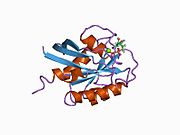











![1iaq: C-H-RAS P21 PROTEIN MUTANT WITH THR 35 REPLACED BY SER (T35S) COMPLEXED WITH GUANOSINE-5'-[B,G-IMIDO] TRIPHOSPHATE](http://upload.wikimedia.org/wikipedia/commons/thumb/4/45/PDB_1iaq_EBI.jpg/180px-PDB_1iaq_EBI.jpg)

![1jah: H-RAS P21 PROTEIN MUTANT G12P, COMPLEXED WITH GUANOSINE-5'-[BETA,GAMMA-METHYLENE] TRIPHOSPHATE AND MAGNESIUM](http://upload.wikimedia.org/wikipedia/commons/thumb/6/62/PDB_1jah_EBI.jpg/180px-PDB_1jah_EBI.jpg)
![1jai: H-RAS P21 PROTEIN MUTANT G12P, COMPLEXED WITH GUANOSINE-5'-[BETA,GAMMA-METHYLENE] TRIPHOSPHATE AND MANGANESE](http://upload.wikimedia.org/wikipedia/commons/thumb/2/2a/PDB_1jai_EBI.jpg/180px-PDB_1jai_EBI.jpg)
